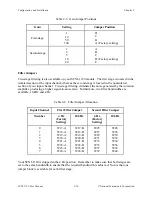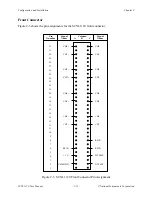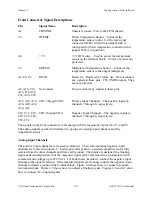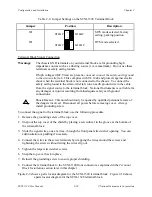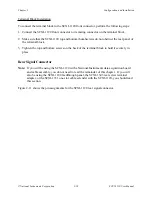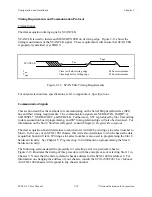
Chapter 2
Configuration and Installation
© National Instruments Corporation
2-13
SCXI-1120 User Manual
Front Connector Signal Descriptions
Pin
Signal Name
Description
A2
CHSGND
Chassis Ground – Tied to the SCXI chassis.
C2
DTEMP
Direct Temperature Sensor – Connects the
temperature sensor to pin 18 of the rear signal
connector MCH7- when the terminal block is
configured for direct temperature connection and
jumper W41 is in position 3.
A4
+5 V
+5 VDC Source – Used to power the temperature
sensor on the terminal block. 0.2 mA of source not
protected.
C4
MTEMP
Multiplexed Temperature Sensor – Connects the
temperature sensor to the output multiplexer.
A6, C6, C8
RSVD
Reserved – Reserved for future use. Do not connect
any signals to these pins. TTL/CMOS output. They
are not protected.
A8, A10, C10,
No Connect
Do not connect any signals to these pins.
A16, C16,A22,
C22, A28, C28
A12, A14, A18, CH7+ through CH0+
Positive Input Channels – The positive inputs to
A26, A20, A24,
channels 7 through 0, respectively.
A30, A32
C12, C14, C18, CH7- through CH0-
Negative Input Channels – The negative inputs to
C20, C24, C26,
channels 7 through 0, respectively.
C30, C32
The signals on the front connector are all analog with the exceptions of pins A6, C6, and C8.
The analog signals can be divided into two groups–the analog input channels, and the
temperature sensor.
Analog Input Channels
The positive input channels are located in column A. Their corresponding negative input
channels are located in column C. Each input corresponds to a separate amplifier and is fully
isolated from the other channels and from earth ground. The inputs are designed in a floating
single-ended configuration, thus the measured signal can be referenced to a ground level with
common-mode voltage up to 250 Vrms. For better noise immunity, connect the negative input
channel to the signal reference. If the measured signals are floating, connect the negative input
channel to chassis ground on the terminal block. Figure 2-4 shows how to connect a ground-
referenced signal. Figure 2-5 shows how to connect a floating signal. Figures 2-6 and 2-7 show
how to connect AC-coupled signals.












